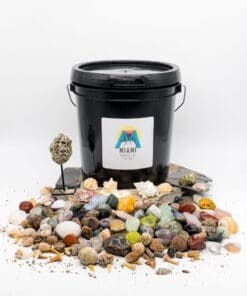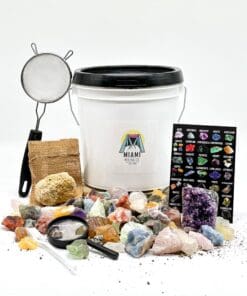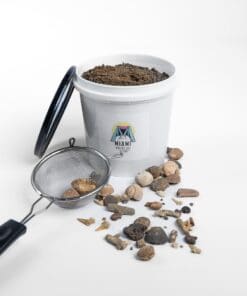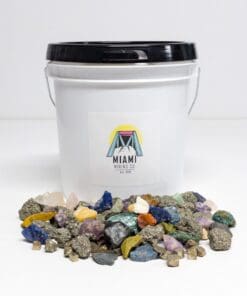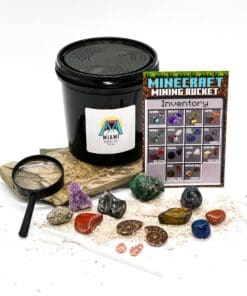New Jersey’s Hidden Gems: A Comprehensive Guide to Gem Mining
Gem mining has long been a captivating pursuit, attracting both hobbyists and serious collectors. In New Jersey, the thrill of the chase and the prospect of finding a hidden gem, literally, has continued to draw individuals from near and far. This article explores the intriguing world of gem mining in the Garden State, its history, the gems to find, and how you can participate.
The Most Popular Gemstones in New Jersey
New Jersey’s geological history has bestowed it with a variety of gemstones and minerals, both common and rare. While these stones have attracted collectors and geologists alike, they also shed light on the area’s rich past. To give you a glimpse, here are lists detailing some of these treasured stones.
Rare Gemstones in New Jersey:

| Gemstone | Description |
|---|---|
| Hardystonite | A calcium zinc silicate that fluoresces a bright blue under ultraviolet light. Primarily found in Franklin. |
| Esperite | This yellowish-white gemstone is known for its strong yellow fluorescence. |
| Clinohedrite | An attractive, orange fluorescent mineral mostly found in the Franklin Furnace region. |
| Tugtupite | A rare tenebrescent gem that can change color when exposed to sunlight. Notable for its vibrant fluorescence. |
| Roeblingite | A lead silicate mineral that is rare worldwide but has been found in the Sterling Hill Mining Museum area. Its red fluorescence is striking. |
Common Gemstones in New Jersey:

| Gemstone | Description |
|---|---|
| Prehnite | Often green in color, it’s a calcium aluminum silicate mineral. Known as the first mineral ever described from the U.S. |
| Quartz | This versatile mineral can be found in various colors, from clear to smoky or even purple (amethyst). |
| Garnet | These deep-red gems are primarily found in the northern regions of New Jersey. |
| Calcite | Known for its diverse crystal forms and its ability to fluoresce under UV light. |
| Zeolites | A group of minerals that can absorb molecules and are often used in industrial applications. |
| Hematite | An iron oxide mineral that’s often used as an ore for its iron content. |
| Magnetite | Another iron ore, this mineral is magnetic, making it easy to identify. |
| Epidote | A greenish-black to black mineral found in metamorphic rocks. |
| Barite | A mineral known for its high density, often used in various industries. |
| Fluorite | Often sought after for its beautiful fluorescence and cubic crystal form. |
While New Jersey might not be globally recognized for its gems, these minerals are essential pieces of the state’s geological jigsaw, providing both beauty and insight into the earth’s history.
Top Gem Mining Locations in New Jersey
- Franklin Mine (Franklin): As one of the world’s most renowned sources of fluorescent minerals, the Franklin Mine remains an iconic destination for gem enthusiasts. The mine boasts unique finds like hardystonite and esperite. While operating hours can vary seasonally, visitors are usually charged an entrance fee, which includes access to the mine and some mineral collecting areas.
- Sterling Hill Mining Museum (Ogdensburg): Beyond its extensive collection of native minerals, the museum allows for hands-on experiences. Visitors can dig through the mine’s tailings in search of treasures. Hours of operation are typically from 10 AM to 3 PM, with entry fees varying based on age and membership status.
- Big Brook Preserve (Colts Neck): A fantastic destination for fossil enthusiasts, Big Brook is known for its Late Cretaceous marine fossils, including the beloved belemnites and shark teeth. It’s free to visit, but ensure you follow preservation guidelines.
- Paterson’s Lambert Castle (Paterson): While not a mine, the surrounding area is known for its trap rock minerals, especially prehnite and zeolites. It’s a haven for rockhounds who have permission to explore the region.
- Passaic Pit (Prospect Park): Home to a variety of minerals like garnet, magnetite, and pyrite, this pit is open to the public. However, you should always exercise caution and ensure safe mining practices.
- Limanska Mine (Allentown): Recognized for its quartz crystals and various fossils, this mine is accessible, though visitors are encouraged to familiarize themselves with the area’s guidelines and regulations.
- Buckwheat Dump (Franklin): An extension of the Franklin mining district, this site offers rockhounds the chance to uncover a plethora of fluorescent minerals. There’s a nominal fee for entry and digging.
- Clayton Sand Pit (Clayton): A unique location primarily for its Cretaceous-era fossilized shark teeth, the site allows visitors to sift through its sands in search of ancient relics.
- Rudeville Fluorescent Rocks (Hamburg): This spot is a draw for collectors interested in fluorescent minerals, particularly willemite and calcite combinations. Visitations might require permissions or fees.
- The Phillips Mine (Tewksbury Township): Primarily a site for copper and iron ores, it also holds interest for those in pursuit of minerals and gemstones related to these ores, like malachite and azurite. Accessibility might vary, so it’s wise to research before visiting.
Exploring New Jersey’s mines is a testament to its rich geological heritage, intertwined with its industrial past. Whether you’re a seasoned miner or just dipping your toes, the state offers diverse opportunities to immerse oneself in the world of gem hunting.
History of Gem Mining in New Jersey

Gem and mineral mining in New Jersey is deeply rooted in the state’s history, tracing back centuries and shining a light on the evolution of both the state’s geological explorations and its socio-economic development.
In the earliest days, indigenous people were the first to identify and use native minerals for tools and ornaments. The European settlers, however, began to recognize the economic potential locked within New Jersey’s land during the colonial era. Iron was among the first minerals to be extensively mined, primarily for the production of tools and weapons. The iron mines, scattered across the northern highlands, played a pivotal role during the Revolutionary War, fueling the Continental Army’s arsenal.
However, it wasn’t until the 19th century that New Jersey began to gain notoriety for its unique mineral deposits, especially in the Franklin and Sterling Hill areas. These locations would eventually become two of the most famous mineral sites globally, attracting attention for their vast array of fluorescent minerals, such as hardystonite and esperite. The significance of this discovery lay not just in their rarity but also in the intrigue of fluorescence itself. This phenomenon spurred both scientific and public interest, causing a miniature ‘rush’ of sorts to these locales.
Yet, the economic boon was not limited to these fluorescent finds. As the state’s mineral wealth became increasingly evident, many mines sprung up. Places like the Paterson region burgeoned due to their rich trap rock minerals. Prehnite, named after Colonel Hendrik Von Prehn and recognized as the first mineral ever described from the U.S., was discovered here, further elevating New Jersey’s status in the mineralogical realm.
The 20th century saw a decline in commercial mining activities, primarily due to exhausted resources and growing environmental concerns. However, many former mines transitioned into educational hubs and tourist attractions. The Sterling Hill Mining Museum, for instance, stands as a testament to the state’s rich mining history, preserving the legacy and continuing to inspire new generations of gem enthusiasts.
Today, while New Jersey may not be at the forefront of commercial mining, its deep-seated history and unique mineralogy remain a source of pride, drawing both researchers and hobbyists to its intriguing geological tapestry.
Gem Mining Regulations in New Jersey


In the rich tapestry of New Jersey’s mining history, the importance of gem mining regulations cannot be understated. These rules, ever-evolving, are vital to balance the collective fascination with gem hunting and the need to protect the state’s environmental and cultural integrity.
One of the primary concerns surrounding gem and mineral mining is the potential environmental impact. When unchecked, digging and extraction can disrupt local ecosystems, affect water quality, and result in landscape degradation. To combat this, New Jersey’s Department of Environmental Protection (NJDEP) has laid down a series of guidelines for mineral extraction and land reclamation.
For individual hobbyists, it’s crucial to understand that most gem mining today in New Jersey takes place in designated areas like former commercial mines turned into tourist attractions. These places often have specific rules about where one can dig, how deep they can go, and the tools they can use. This approach ensures that the impact on the land is minimal and the area remains safe and accessible for future visitors.
Trespassing is a significant concern in the realm of gem hunting. A plethora of old mines and potential dig sites are on private property. Always seek permission before venturing onto private lands. Unauthorized trespass can lead to legal repercussions and strain the relationship between landowners and the gem-hunting community.
Furthermore, certain areas, especially those of historical or cultural significance, may have restrictions or outright bans on collecting. Such regulations protect the state’s heritage, ensuring that future generations can learn from and appreciate these sites.
Transporting and selling the gems you find is another area governed by regulation. While personal collections are generally unrestricted, commercial selling might require permits, especially if the volume is significant. New Jersey’s stance is clear: while gem hunting is a cherished pastime, it shouldn’t become a commercial exploit at the cost of the state’s resources.
Safety regulations, too, are paramount. Mines, especially old ones, can be hazardous. There’s always the risk of cave-ins, exposure to harmful substances, or encounters with wildlife. As a result, many old mines are off-limits to the public. Those open for exploration often provide guidelines and sometimes even mandatory guided tours to ensure public safety.
In conclusion, while New Jersey welcomes gem enthusiasts, it emphasizes responsible and informed gem hunting. Knowledge of the state’s regulations is not just a legal imperative but a nod to the respect for the land, its history, and the treasures it holds.
Necessary Tools and Equipment for Gem Mining in New Jersey
Embarking on a gem mining adventure in New Jersey requires more than just enthusiasm. Proper tools and equipment can greatly enhance the experience, ensuring both fruitful discoveries and personal safety. Given the varied terrains and mining conditions in the state, it’s essential to be adequately equipped.
1. Screening and Classifying Tools: Reveal those hidden treasures!
Description: Especially useful when searching for smaller gems or fossils, these screens allow you to filter out larger rocks and debris, leaving potential treasures behind.


🛒 Explore Top Screening Sets on Amazon
2. Shovels and Trowels: Digging deep or just scratching the surface?
Description: These are fundamental for digging into soil or loosening rock formations. Depending on your mining location, a smaller hand shovel might suffice, or a larger pick might be necessary for harder terrains.


🛒 Find Quality Shovels and Trowels on Amazon
3. Picks and Hammers: The backbone of any gem hunting endeavor.
Description: This is the quintessential tool for any rockhound. A dual-purpose hammer, it has a flat head for breaking rocks and a pointed tip to extract minerals from hard-to-reach crevices.


🛒 Check Out Best Picks and Hammers on Amazon
4. Buckets: Your trusted companion for carrying treasures.
Description: These are essential for carrying soil to sift or to safely store the gems you find. Remember to clearly label your finds, so you can later identify and categorize them.

🛒 Shop for Reliable Buckets on Amazon
5. Magnifying Glass: Every detail counts!
Description: This magnifying tool helps in closely inspecting potential gems, ensuring you don’t overlook small but valuable stones. It’s also beneficial for identifying inclusions or other distinguishing features in your finds.


🛒 Grab Your Magnifying Glass on Amazon
6. Guidebooks and Field Guides: Knowledge at your fingertips.
Description: A comprehensive field guide on Montana’s gemstones can provide invaluable insights, assisting in identification and offering tips on where specific gems might be found.


🛒 Discover the Best Field Guides on Amazon
7. Containers and Bags: Organize, store, and flaunt your finds.
Description: As you collect specimens, having durable bags or containers prevents damage to your finds and makes it easier to carry them.


🛒 Shop for Storage Solutions on Amazon
8. First Aid Kit: Better safe than sorry!
Description: Accidents can happen. A basic first aid kit with bandages, antiseptics, and other essentials is crucial.


🛒 Shop for your First Aid Kit on Amazon
Being well-equipped not only maximizes the chances of fruitful discoveries but also ensures a safe and enjoyable gem hunting experience in the rich terrains of New Jersey.
Tips and Tricks for Successful Gem Mining in New Jersey
New Jersey, with its storied mining history and diverse geology, offers a treasure trove of opportunities for gem enthusiasts. However, maximizing the chances of a successful mining expedition requires a blend of preparation, knowledge, and field strategies. Here are some essential tips and tricks to help you unearth the Garden State’s hidden gems:
- Research Ahead: Before you set foot on a mining site, invest time in researching. Understand the types of minerals you’re likely to find, the best seasons to visit, and any site-specific guidelines.
- Start Early: Many seasoned miners swear by the adage, “the early bird gets the worm.” Arriving early allows for uninterrupted exploration and increases the chances of making significant discoveries before areas become crowded.
- Work Systematically: Instead of randomly digging, work in a methodical manner. Section off areas and work your way through them. This approach ensures that you cover ground effectively and don’t miss potential spots.
- Learn the Land: Understanding geological formations can give you an edge. For instance, quartz veins often signify the presence of other valuable minerals. Similarly, low points or crevices are often collection points for smaller gems.
- Connect with Locals: Engage with local gem enthusiasts or join a rockhounding group. Their experience and insights can provide invaluable guidance, and there’s often a sense of community camaraderie that can enhance the experience.
- Hydration and Nutrition: Gem mining can be strenuous. Carry sufficient water to stay hydrated, and pack snacks or a lunch to keep energy levels up.
- Mind the Environment: Always prioritize the environment. Refrain from littering, and after digging, restore the site as best as you can. Respecting nature ensures that these sites remain accessible and preserved for future generations.
- Practice Patience: Gem mining is as much about patience as it is about skill. You might not strike gold immediately, but persistence often pays off. Celebrate the small finds and treat each expedition as a learning experience.
- Documentation: Keep a journal. Documenting where and what you find can provide insights for future expeditions and helps in understanding patterns.
- Stay Updated on Regulations: As mentioned in the previous sections, regulations can change. Regularly check for updated guidelines to ensure you’re always compliant.
- Prioritize Safety: Never venture into closed mines or risky terrains. It’s better to miss out on a potential find than to jeopardize personal safety.
Embarking on a gem mining expedition in New Jersey is a journey of discovery, patience, and respect for nature. With the right strategies and a sense of adventure, every trip can be a rewarding experience, unveiling the state’s geological wonders.
Handling Your Gemstone Finds


Once you’ve successfully unearthed some of New Jersey’s geological treasures, the next crucial step is to handle, clean, and care for your finds properly. Gemstones, especially in their raw form, can be fragile, and handling them with care ensures their preservation and showcases their natural beauty.
- Initial Cleaning: Begin by gently brushing off any loose dirt or mud using a soft brush. You can then rinse the gemstones in lukewarm water. Avoid using hot water as it can cause some minerals to fracture.
- Deeper Cleaning: For stubborn dirt or encrustations, a solution of mild dish soap and water can be helpful. Gently scrub the gemstones with a soft toothbrush, ensuring you reach all crevices.
- Advanced Cleaning Techniques: Some minerals may require specific cleaning methods. For instance, iron-stained quartz can benefit from a soak in oxalic acid, but always research and ensure that your cleaning method won’t damage the specific gem.
- Drying: Allow the gemstones to air dry on a soft towel. Avoid direct sunlight, which can cause some minerals to fade.
- Storage: Store gemstones individually, especially softer minerals which can scratch easily. Wrapping them in soft cloth or placing them in individual boxes is ideal. Remember to label them, especially if you’re building a collection.
- Displaying: If you wish to display your finds, invest in proper display cases that protect them from dust and direct sunlight. An illuminated case can further highlight the gem’s beauty.
- Identification: If you’re unsure about a gemstone’s identity, consider investing in a gem identification book or consult with a local geology expert or gemologist.
- Valuation: While many gem hunters collect for personal pleasure, knowing the value of your find can be gratifying. Seek out certified gem appraisers for accurate valuations.
- Handling: Always handle gemstones with clean hands. Natural oils from the skin can affect some minerals. Using tweezers or cloth gloves can help in preventing direct contact.
- Preservation: Some gemstones, like amber, can degrade over time if not stored properly. Research the specific care requirements for each gemstone in your collection.
Remember, each gemstone you find is a piece of New Jersey’s rich geological tapestry. Treating them with respect and care ensures they remain timeless treasures, offering beauty and insights into the state’s vibrant natural history.
Famous Gemstone Finds in New Jersey
New Jersey’s geology has given birth to many memorable stories and notable discoveries. Over the years, the state has made headlines with several remarkable gemstone finds that have captivated enthusiasts, historians, and the general public alike.

- The Franklin Fluorescent Discovery: The town of Franklin is renowned as the “Fluorescent Mineral Capital of the World.” The most famous find from this locale is the mesmerizing trove of over 90 different fluorescent minerals. When illuminated under ultraviolet light, these minerals glow in a stunning array of colors. This discovery revolutionized the world of mineralogy and put New Jersey on the global map for gem enthusiasts.
- The Traprock Garnets: Garnets are usually associated with metamorphic rocks, but New Jersey surprised geologists with the discovery of large, high-quality garnets in traprock quarries. These garnets, boasting a deep red hue, challenged conventional wisdom and underlined the state’s geological uniqueness.
- The Watchung Zeolites: In the Watchung basalt flows, a series of remarkable zeolite minerals were discovered. Not only are these crystals beautiful, but they’ve also provided invaluable insights into the cooling and formation of basaltic lava.
- Prehnite Treasures: Prehnite, the state’s official mineral, was first described from a find in the Palisades sill. Its lovely pale green hue and unique crystalline structures make it a sought-after specimen by collectors.
- The Delaware Riverbed Agates: Along the shores of the Delaware River, agate hunters have found beautifully banded and colorful specimens. These agates are often smooth and polished naturally, testaments to the river’s erosive power.
- The Sterling Hill Mining Museum’s Wonders: While not a singular find, Sterling Hill boasts an extraordinary variety of minerals. The ores in this old mine have been a source of fascination for decades, with over 350 mineral species identified, some of which are not found anywhere else in the world.
- Tourmalines of the Highlands: While not as abundant as in other regions, the New Jersey Highlands have occasionally yielded beautiful tourmaline crystals, adding to the state’s mineralogical diversity.
- Amethyst from the Kittatinny Valley: Rare finds of amethyst, with their captivating purple hue, have been reported in the Kittatinny Valley, making them prized possessions for local collectors.
Each of these famed discoveries tells a unique story, weaving together elements of chance, geology, and human curiosity. These finds, both historic and recent, continue to underscore New Jersey’s reputation as a haven for gem and mineral enthusiasts, offering tantalizing glimpses into the Earth’s vibrant and diverse mineral heritage.
Additional Gem Mining Opportunities
For those who have enjoyed the gem mining experiences in New Jersey and are eager to explore further, the neighboring states also offer fascinating and rewarding opportunities. Here’s a list of these states, showcasing the diverse mineralogical riches of the Northeast:
- New York Gem Mining: Just to the north of New Jersey, New York boasts a diverse array of minerals, from Herkimer diamonds to beautiful garnets in the Adirondack Mountains.
- Pennsylvania Gem Mining: West of New Jersey, the Keystone State offers plenty of gem hunting opportunities. Known for its diverse fossils, Pennsylvania also houses beautiful quartz crystals and amethysts.
- Delaware Gem Mining: South of New Jersey, Delaware might be small, but it’s rich in minerals. The state has a long history of mining, with finds including jasper, quartz, and calcite.
- Connecticut Gem Mining: To the northeast, Connecticut is renowned for its garnets and beryl. The state’s diverse geology offers numerous gem hunting locales.
- Maryland Gem Mining: A bit further southwest, Maryland boasts a wide array of minerals, from agates to quartz. The state’s varied topography provides numerous sites for gem enthusiasts.
By exploring New Jersey and its neighboring states, gem enthusiasts can embark on a diverse and rewarding journey, delving into the rich geological tapestry of the American Northeast. Whether you’re a novice or a seasoned rockhound, the region promises a treasure trove of discoveries waiting to be unearthed.
Enhance your gem mining knowledge by exploring our in-depth Gem Mining Near Me guide.
The Enchantment of Gem Exploration & Home Mining Kits
Gem hunting in New Jersey is more than just a pursuit; it’s an entrancing journey that beckons enthusiasts to experience the state’s rich geology first-hand. With every find, one uncovers not only a physical treasure but also a storied fragment of New Jersey’s deep-rooted geologic narrative. Each gemstone is a testament to the state’s diverse mineralogical heritage, providing a tactile connection to epochs long past.
However, for those who may find it challenging to embark on field trips, or for those who wish to introduce the joys of gem discovery to a younger generation in a more accessible way, there’s an exciting alternative: Gem Mining Kits. These kits bring the magic of gem hunting right to your doorstep, offering an array of raw gemstones ready to be unearthed from the comfort of your home. Whether you’re an aficionado or a novice, these kits encapsulate the allure of the hunt, bridging the gap between nature’s subterranean wonders and your living room. Dive in and experience the thrill of discovery anew!

